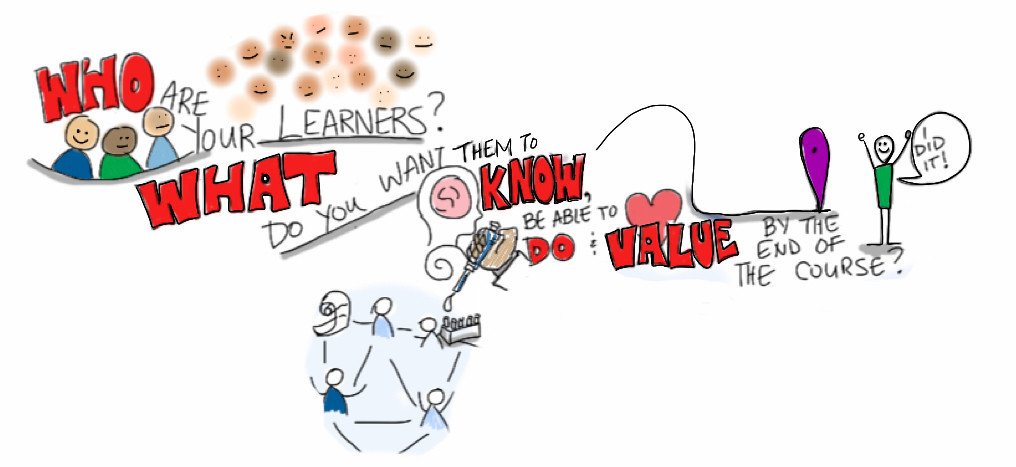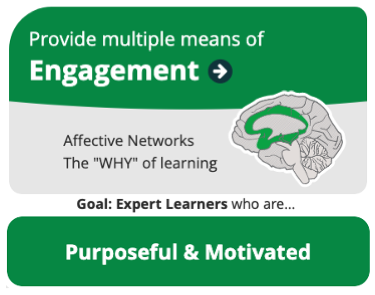Session 3: UDL Affective Networks

To do this session
✓ Complete the required readings of linked resources, videos and websites and explore the recommended reading resources
✓ Create your empathy map
✓ Consider the reflection questions
Session Introduction
One of the greatest challenges of designing this course was ensuring it was going to be most useful to you, the learner. If you have taken ADED 4F33/2F92 (they changed the code) then you will have encountered some principles from Malcolm Knowles (1984) Andragogy in action (Brock University ADED 2F92 slides, p. 8).
Adults need to be involved in the planning and evaluation of their instruction.
Adults are most interested in learning subjects that have immediate relevance to their job or personal life.
Adult learning is problem-centred rather than content-oriented.
 Yet, there is a definite and important requirement to have a course fully created with all sessions complete well before the start of term. Having the requirements for success in a course laid out is essential and knowing what content each of the sessions will cover is also an important tenet of good pedagogy.
Yet, there is a definite and important requirement to have a course fully created with all sessions complete well before the start of term. Having the requirements for success in a course laid out is essential and knowing what content each of the sessions will cover is also an important tenet of good pedagogy.
So how do we reconcile fundamental adult learning principles of allowing learners to be involved in the planning and evaluation with setting expectations and providing access to materials in a timely way? When you design something that is going to be used by someone else—a lecture, an activity, an assessment—you must first understand what that person needs. For example, when architects design a building, they put aside their own desires and think about what the users of that building need.
As Stommel (2017) says, “when we teach online, we have to build both the course and the classroom”. How do we balance responsiveness to student need with desired outcomes of a course, program, and degree? One answer to this lies with Universal Design for Learning (CAST, 2018).
As you will see in the video, “neuroscience tells us that our brains have three broad networks, one for recognition (The What of learning), one for skills and strategies (The How of learning) and one for caring and prioritizing (The Why of learning).” We will dig deeper into Universal Design for Learning (UDL) over the next few weeks but this week, we will focus on the Why of learning, or the affective network.
As you will see on CAST’s UDL site, numerous research studies have shown, “affect represents a crucial element to learning, and learners differ markedly in the ways in which they can be engaged or motivated to learn”. As Stewart (2014) describes, planning learning is not enough: authority, presence, guidance are still essential.
Based on the eCampusOntario Ontario Extend Technology module, the activity this week asks you to empathize with your user—your learner—to identify a challenge that could be solved through the purposeful use of technology in your curriculum. It asks you to:
Gather information from and about your learners. You may already have useful information that you have gathered through feedback from course evaluations, emails, and other communication, but ideally, you’ll create a specific method of gathering feedback for this exercise. You might do this through conversations or other forms of communication.
Ask you learners what they think, feel, say, do, see, and hear. What do they have difficulty understanding or doing in your course?
So far in this course, the activities were designed to better understand who you are as learners. These data were used to create a first draft of an Empathy Map for this course. As the extend module suggests, after you have completed the empathy map as an instructor, you should check back with your learners to ensure we have captured their perspectives. Therefore, the link to this empathy map is editable; feel free to add anonymous posts to give the instructor a fuller picture of who you are as a learner in this course.
- Reflect on the feedback you’ve collected from your learners and begin sketching your empathy map. You can do this on paper or in a Word document, or we’ve developed an Empathy Map Template with fields for the above guiding questions.
- Go into the File menu, Click on Save As. Rename the file for yourself, save in your personal OneDrive space and complete the template for your learners.
Learning Outcomes
By the end of this session you should be able to:
- create an empathy map to determine important details about your learners;
- familiarize yourself with learning with the six principles of effective learning from a cognitive psychology perspective; and
- using the Universal Design for Learning guidelines, describe what changes could be made to this session to allow for multiple means of representation, multiple means of expression, and multiple means of engagement.
Rationale
The most important factor for learning is meeting your learners where they are. Using design thinking to analyze different online teaching & learning strategies will help you create a better learning experience.
Connection to Theory
Universal Design for Learning and the Six Strategies for Effective Learning both tap into learner engagement providing evidence-based research.
Connection to Practice
As we move through this course, we will often be switching perspectives from learner to teacher. The course is attempting to model the principles so you can experience them from a learner perspective but also to ensure that the course work is most relevant and meaningful to your work as a teacher.
Session Resources
- Stommel, J. (2013). How to build an ethical online course. Hybrid Pedagogy.
- Stewart, M. (2014). Designing for Emergence: The role of the Instructor in Student-Centered Learning. Hybrid Pedagogy.
- CAST (2018). Universal Design for Learning Guidelines version 2.2.
Learning Activities
Forum Discussions
Share your empathy map. Give some contextual information for our learning community: describe a course you may be teaching and a little bit about who you think your learners are. If you currently have learners you work with, you should consider them in this map. If you have already completed ADED 4F33/ ADED 2F92, and created a 12 week course as your culminating assignment, you could consider the learners you imagined for that assignment. If you have not taken that course and don’t currently have any students, this activity will have to be hypothetical and you should imagine who you would like to be teaching in your ideal scenario.
Quiz
Reflection
Weekly reflections are recommended.
Here are some guiding questions to help you structure your reflection for this week:
- Do you think it is the instructor’s responsibility to modify a course based on the learners?
If yes, is this practical? - What would that look like in your context? What considerations would you make?
How do you feel about authority, presence, and guidance (from a learner perspective / from a teacher perspective) - What kinds of learning outcomes could you make concrete and what could you make flexible?
Bridge to Next Session
Online teaching and learning strategies span from content to facilitation and there are affordances and limitations of both. Similarly, we will look at online tools next session.

